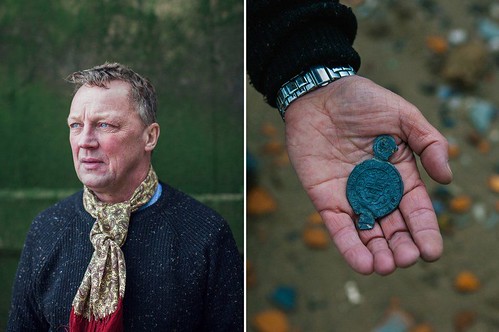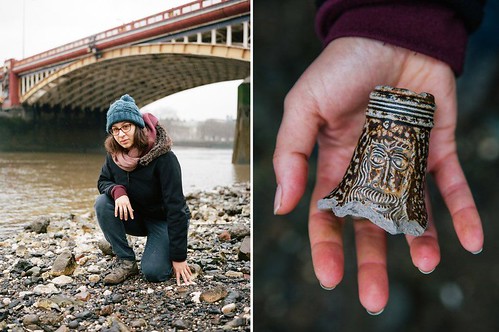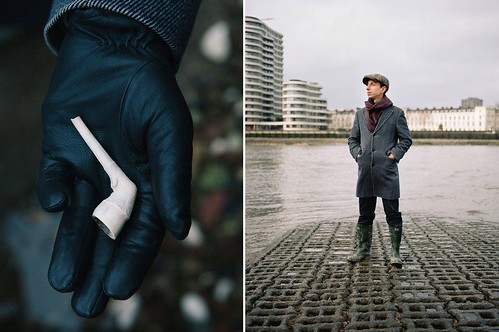
PREV ARTICLE
NEXT ARTICLE
FULL ISSUE
PREV FULL ISSUE
MEET THE MUDLARKSDick Hanscom of Alaska forwarded a BBC profile of London's mudlarks, who men and women who comb the banks of the Thames river in their spare time searching for artifacts,
including coins, medals and seals. Here's an excerpt. -Editor
Joseph Fox photographed the mudlarkers who comb the shore of London's River Thames. Originally a term for the city's poor who scraped a meagre living by scavenging in the river's mud, it has been adopted by a new breed of treasure hunters, often armed with metal detectors. These men and women show off their favourite finds, and discuss the joys of mudlarking. Dave Hiddleston, Limehouse
 Long fascinated by history and collecting, Dave first discovered mudlarking while he was working on Cannon Street and saw people on the foreshore in wellington boots. His favourite find is an English community cloth seal, which he believes was used to stamp cloth bags coming through London in about 1618. It was inside a lump of burnt cinder. Sara Cannizzaro, Vauxhall
 It's the unexpectedness of mudlarking that drew Sara to it, in contrast to the routine of London life. "I feel the excitement when I'm walking along the bank," she said. "It's a way of making order out of chaos." Sara has managed to find a piece of Bartmann jug, which - from the splashes of cobalt blue glaze - she has dated to 1600-20, made in Frechen. She said: "The face that was impressed on the neck of these jugs is a prized find from all mudlarkers - everyone wants to find one!" Flickr follower Stuart Williams of Ireland writes: I used to do that when living in London during the late 80s and early 90s. Me and the children would drive in on Sundays to catch the ebbing tide and walk from Trigg Stairs along the foreshore picking up anything of interest we found. Free parking on Sundays and no driving restrictions then. Load of interesting potshards which are great for research and by researching to identify them, we learned a lot about pottery. There were plenty of 17th and 18th century clay pipe heads and stems. I once found a portion of the bottle neck having half a face (Bartmann jugs). Antique nails but alas, we never did find any coins or tokens on those visits. It was a great way to spend a Sunday morning, very fulfilling and educational. Sadly, it's been commercialised and even to walk the foreshore now, one needs a permit and I understand they cost a lot of money! Edward Sandling, Vauxhall
 Ted discovered mudlarking by chance. "I was walking along South Bank," he said, "and I just hopped over a gate and came down to the foreshore. You get a sense of quietude and the perspectives on the city are so different, just by that small change of level." He then noticed the objects at his feet, such as this pipe stem shaped like a horse's hoof. He said: "I have finds that are older and perhaps more beautiful, but this is the one that set it all off. "It's absolutely beautiful. To hold it and know that someone else was smoking it 150 to 200 years ago is amazing." Stuart Williams adds: Those horse hoof pipes are surprisingly common. They date from the late 19th to the early 20th centuries. I used to find a lot of clay pipe heads and fragments with most of them being 17th and 18th centuries. All were plain with no interesting designs, alas! Sometimes a pipe head dating to the 16th century would also be found. To read the complete article, see:
 Wayne Homren, Editor The Numismatic Bibliomania Society is a non-profit organization promoting numismatic literature. See our web site at coinbooks.org. To submit items for publication in The E-Sylum, write to the Editor at this address: whomren@gmail.com To subscribe go to: https://my.binhost.com/lists/listinfo/esylum All Rights Reserved. NBS Home Page Contact the NBS webmaster 
|